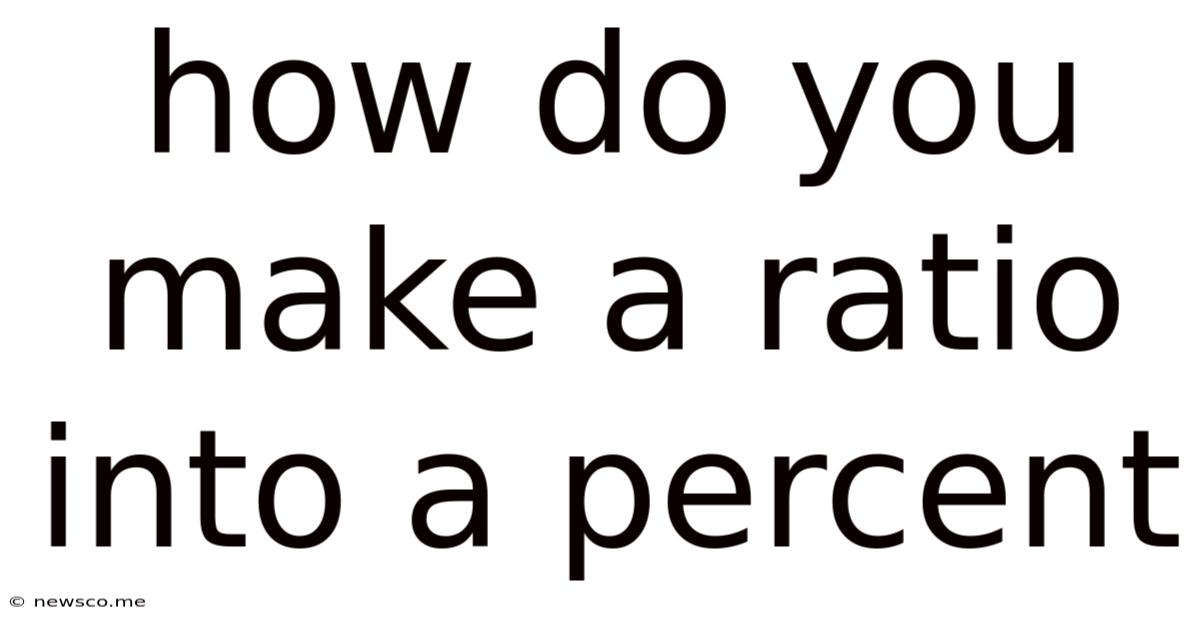How Do You Make A Ratio Into A Percent
News Co
Apr 11, 2025 · 4 min read

Table of Contents
How Do You Make a Ratio Into a Percent? A Comprehensive Guide
Converting a ratio to a percentage is a fundamental skill with widespread applications across various fields, from finance and statistics to everyday calculations. Understanding this process allows you to express proportions in a universally understood and easily comparable format. This comprehensive guide will walk you through the steps, providing numerous examples and addressing common challenges.
Understanding Ratios and Percentages
Before diving into the conversion process, let's clarify the concepts of ratios and percentages.
Ratio: A ratio shows the relative size of two or more values. It's expressed as a fraction (e.g., 1/2, 3/4) or using a colon (e.g., 1:2, 3:4). The ratio 1:2 indicates that for every one unit of the first value, there are two units of the second value.
Percentage: A percentage is a way of expressing a number as a fraction of 100. The symbol "%" represents "per cent" or "out of 100." For example, 50% means 50 out of 100, or 50/100, which simplifies to 1/2.
Converting Ratios to Percentages: A Step-by-Step Guide
The core principle in converting a ratio to a percentage lies in transforming the ratio into a fraction and then expressing that fraction as a number out of 100. Here's the process:
Step 1: Express the Ratio as a Fraction
If your ratio is already in fraction form, you can skip this step. If it's given using a colon (e.g., 3:5), rewrite it as a fraction (3/5).
Step 2: Divide the Numerator by the Denominator
Divide the top number (numerator) of the fraction by the bottom number (denominator). This gives you a decimal value.
Step 3: Multiply the Decimal by 100
Multiply the decimal obtained in Step 2 by 100. This converts the decimal to a percentage.
Step 4: Add the Percentage Symbol (%)
Finally, add the percentage symbol (%) to indicate that the result is a percentage.
Examples: Illustrating the Conversion Process
Let's work through several examples to solidify your understanding.
Example 1: Simple Ratio
Convert the ratio 1:4 to a percentage.
- Fraction: 1/4
- Division: 1 ÷ 4 = 0.25
- Multiplication: 0.25 × 100 = 25
- Percentage: 25%
Therefore, the ratio 1:4 is equivalent to 25%.
Example 2: Ratio with Larger Numbers
Convert the ratio 12:25 to a percentage.
- Fraction: 12/25
- Division: 12 ÷ 25 = 0.48
- Multiplication: 0.48 × 100 = 48
- Percentage: 48%
Thus, the ratio 12:25 represents 48%.
Example 3: Ratio Greater Than 1
Convert the ratio 5:2 to a percentage.
- Fraction: 5/2
- Division: 5 ÷ 2 = 2.5
- Multiplication: 2.5 × 100 = 250
- Percentage: 250%
Note that percentages can exceed 100%. This signifies that the numerator is larger than the denominator.
Example 4: Ratio Involving Decimals
Convert the ratio 0.75:1 to a percentage.
- Fraction: 0.75/1
- Division: 0.75 ÷ 1 = 0.75
- Multiplication: 0.75 × 100 = 75
- Percentage: 75%
Handling Ratios with More Than Two Values
While the examples above focus on ratios with two values, the principle can be extended to ratios involving more values. The key is to focus on the proportion you are interested in expressing as a percentage.
For instance, consider the ratio 2:3:5. If you want to express the proportion of the first value (2) relative to the total (2+3+5 = 10), you would follow these steps:
- Fraction: 2/10
- Division: 2 ÷ 10 = 0.2
- Multiplication: 0.2 × 100 = 20
- Percentage: 20%
Therefore, the first value (2) represents 20% of the total. You can similarly calculate the percentages for the other values (3 and 5) in the ratio.
Practical Applications and Real-world Scenarios
The ability to convert ratios to percentages is invaluable in various contexts:
- Finance: Calculating interest rates, profit margins, and investment returns.
- Statistics: Representing data proportions in charts and graphs.
- Science: Expressing experimental results and probabilities.
- Everyday Life: Understanding discounts, sales tax, and survey results.
Common Mistakes to Avoid
- Incorrect Order in Fractions: Always ensure the correct value is the numerator (top) and the total is the denominator (bottom).
- Forgetting the Percentage Symbol: Always include the "%" symbol to clearly indicate a percentage.
- Rounding Errors: Be mindful of rounding errors, especially when dealing with multiple calculations. It's good practice to maintain several decimal places during intermediate steps and only round the final result.
Advanced Techniques and Further Exploration
While the basic method outlined above is sufficient for most scenarios, more advanced techniques exist for dealing with complex ratios and proportions. These often involve using algebraic methods or spreadsheet software to simplify calculations, especially when working with large datasets or intricate relationships.
Conclusion: Mastering Ratio-to-Percentage Conversions
Converting a ratio to a percentage is a straightforward yet powerful tool. Mastering this skill enhances your ability to analyze data, solve problems, and communicate information effectively across numerous disciplines. By understanding the steps involved and practicing with different examples, you will gain confidence and proficiency in this essential mathematical skill. Remember to focus on the fundamental principles, avoid common pitfalls, and explore advanced techniques as needed to confidently tackle any ratio-to-percentage conversion you encounter.
Latest Posts
Related Post
Thank you for visiting our website which covers about How Do You Make A Ratio Into A Percent . We hope the information provided has been useful to you. Feel free to contact us if you have any questions or need further assistance. See you next time and don't miss to bookmark.